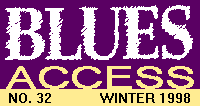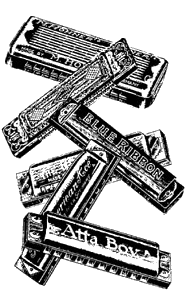

 | ||
| The Doctor is In! |
Some tangible evidence that somebody out there actually reads this stuff ..

Dear Harpo,
Iím clucking all around the barnyard here, and my feathers are ruffled in Pittsburgh!
Iíve been using the "Butter Vibrato" for 20 years to grease up my solos, and I ainít had any complaints yet! Michael Bloomfield was right when he told Stuart Laughton how to do it, but I would describe it more as a deep "throaty laugh" while drawing in, of course. The larynx actually moves up and down when you got it!
I still regard you as a love object, and Iíve never even seen ya! Love your writing.
Lucy Van Sickle
Pittsburgh, Pennsylvania
Gnawing distractedly at a shard of cuttlebone, the Human Uvula returns to pecking at his image in the mirror as he wraps his toes around a perch. The perch wriggles free and swims off, muttering. What else was in that breakfast?
Dear Lucy,
Judging by the clippings that you sent along, youíre doing a fair amount of feather-ruffling in the greater Pittsburgh area yourself. I think youíre onto something with your laryngeal calisthenics. If you can get that little number to bob up and down like a yo-yo, the Butterfield rapid-fire vibrato will be yours. I tried it and got a contusion on my clavicles, but Iíve got an Adamís apple the size of a smoked shoulder. By the way, I understand completely how you find yourself reduced to treacle when you read my column. I was the technical advisor for costuming the male lead in Dr. Detroit, and they toned me down a bit in the movie. Keep on showiní em how itís done!
Dear Harpo,
Hello. My name is Pablo. Iím a Mexican harp player. This is the first time I saw what you write for a magazine. I love harmonica, maybe as much as many other harp players do.
Could you let me know some secrets and techniques of third position and let me know the name of the musician, the name of the song and Iíll try and find the tape.
I have also a question: Do you know what damage a harp player could do to a dog? When I practice harmonica my dog starts howling. I guess the high frequency hurts their ears, so I go outside. Is that right? What do you know about it?
About Mexican blues music scene, there is not much. There is a market on the street by the train station where on Saturday morning you can buy used CDs, recorded tapes, T-shirts, magazines, used musical instruments, old U.S. records of any kind of music: heavy metal, punk, pop, rock, alternative, jazz and blues. There are about four or five bands, but they just play a couple of places, they almost never play and most of them are big stars that do not give you a chance to play harmonica.
I have heard Piazza, deLay, Traveler, but I never get tired of listening to Kim Wilson of the Fabulous Thunderbirds. He is my favorite, I play most of his songs (some are third position). What about SPAH? What about microphones? I can get old ones here. Thank you.
Pablo Barrera Godinez
Calle Golondrinas #124
col. Benito Juarez
cd. Neza edo de Mex
Mexico C.P. 57000
Dear Pablo,
Thanks for your looooong letter. I edited it down to leave only your gazillion questions. Here goes:
1) Short answer for 3rd position is, practice on a chromatic, like the way Rod Piazza does. Long answer, you have a major chord on blow, the same one repeated for 10 holes and a minor 6th chord on holes 4Ė7. Thatís mostly what works on 3rd position. With patience, you can build on that basic framework and use the other notes for passing tones on your way to the "good notes" that you know will sound good in a song. I like Rod Piazzaís "Tribute to George Smith" and Charlie Musselwhiteís "Christo Redentor" as 3rd position classics.
2) If your dog howls and stays in the room with you when you play, I think heís probably joining in with you, rather than criticizing your playing. Dogs will retreat from things that scare them, like veterinarians and obnoxious kids. I had a friend, David Brownlee, who used to take his seeing-eye dog to clubs and gigs with him, and the dog would just curl up at his feet and listen. I know the dog wasnít deaf ó he just loved David and his playing.
3) Old microphones, like old people, tend to age at different rates and have different personalities that either improve or worsen with time. That said, Iíll take a vintage mic over a new one, because as a general rule, old mics have more richness of tone than a new one right out of the box. That may have to do with the materials used in manufacturing an older mic being better quality, more massive casings, different wiring and so on, or it may have to do with the process of aging changing the materials over time.
Crystal mics gradually decay over time because the elements absorb water and eventually break down the crystals (which is why they call them Ö) in the element that produces the sound. But as it takes on water, it sounds warmer and fuzzier, gaining more of that crystal mic sound as it slowly degenerates, finally crapping out when the sound is perfect. Isnít life strange?
4) SPAHís address is: Box 865, Troy, MI, Estado Unidas 48099-0865.
5) In reading your letter, I couldnít help thinking how difficult it must be to try and feed your harp frenzy in your situation you describe. If any harpoholics want to correspond with Pablo, send him your ideas or recordings, I think heíd welcome the help. Talk about the blues!
Pabloís got his problems, but his options must look like the whole enchilada to someone whoís down in the hole, Down Under. But donít chunder Ö read on.
Dear Harpo,
I need to ask you for some real advice on which tube amp to buy. I understand that everyone has their own ideas on what good harp tone is, and I also understand that the older, original amplifiers and mics are recommended, but there are a number of issues that make purchasing an amp an extremely scary task for me. I have written letters all over the world asking people for specific names and models of amps which work well for harp and have had only minimal luck regarding specifics. Tom Ellis recommended an Ampeg Jet, but I have not been able to find one anywhere, and in fact was told that they are not imported into Oz. I was also told by someone to buy a Fender Blues Deluxe Tweed Series, but they are extremely hard to find now as they are being superseded by the new hot-rod range, I think. I got to try out a small Peavey Classic 20, but it didnít seem to distort real well with a Hohner Blues Blaster and sounded absolutely shitty with my 520D Green Bullet. The factors which make buying an amp a scary thing for me are as follows:
1) I must buy from music shops in close proximity to the prison, as it is prison policy to purchase goods locally. This means that I am only able to buy newer amps easily available, such as Fender, Peavey, Marshall, Laney, etc., not second hand stuff.
2) I cannot try before I buy, as the shops wonít allow for the prison canteen guy to bring them in for me to try out. (I was lucky that my music teacher was lent the Classic 20 by one of his mates!)
3) I can only afford amps in the 30Ė40 watt price range, which is about $1500 Australian. (Fender Bassmans and Vibroverb reissues cost about $2300Ė2400 over here!) I have been saving for months and months to get where I am, so a í59 Bassman is just too expensive for me, not to mention too large for prison use!
I want a good, bright, distorted sounding amp, not a deep, muffled-sounding one. Maybe I am asking too much for my price range, and from newer tube amp models, but I just want one that will distort with a blues/rock type honk. Iíve got some money, now all I need is a make and model!
John Carroll
c/o Box 611
Cockatoo, Victoria, Australia 3781
Wait a minute, werenít those cockatoo feathers we last saw being
ruffled in Pittsburgh? Those birds certainly do get around! Itís enough to give
the Doc the spins ó mustíve been too many mixed metaphors last night. Back to
John, down by law with no good amp in sight.
Dear John,
I donít blame you for being frustrated. Bad enough to be stuck in prison, without having your musical gear go into open revolt on you. You have the universal harp-playerís conundrum: No one is forever satisfied with their amp and mic combination and no one has the ultimate answer. As I advised River Blue when he went into the studio, try every combination that you possibly can, because the ultimate rig for playing doesnít exist: Itís largely dependent upon the characteristics of the place in which you play. That said, you donít have an unsolveable problem, although you are limited in you flexibility. Go with all tubes, 10-inch speakers and a name brand like Fender. Smaller is cheaper, so get something akin to an old Princeton, or even a Champ, which has an 8-inch speaker. This shouldnít take all of your dough, so you can then sink some money into a foot-pedal graphic equalizer with a gain control on it. This allows you to fart around with the nuances of tone to enhance the sound and eliminate the feedback frequencies. Personally, I hate Marshalls and Peaveys for harp, since theyíre primarily guitar amps and donít give that fat sound. Laneyís a mystery to me, so I canít help you there. If you get a small Fender and crank the bejeezus out of it, itíll rip just fine, especially if you doctor the sound with the EQ. With that much flexibility, who needs a Bassman, especially at your prices?
Hey, gang, are you getting the impression that this guy could use some pen pals? Send him the stuff that you donít send to Pablo in Mexico, and drop him a line with some of your suggestions for equipment and set-up. Heíd greatly appreciate it!
And keep those bon mots and bent notes coming to the daffy Doc:
 |
 |